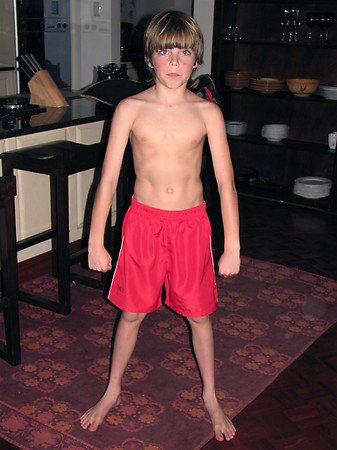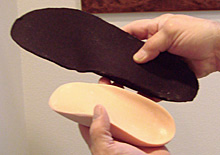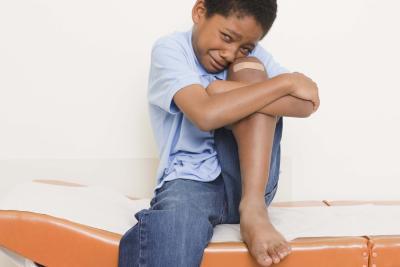Leg Cramps in Children
Would all of you who have had “growing pains” please raise your hands.
Just as I thought, most of you have. You should know however, that even though many doctors use that as a “talking with parents” diagnosis, most of us realize there should really be no such thing as a pain caused by merely “growing.”
No Such Thing As A Growing Pain
There really should be no reason for any normal bone, joint, muscle, or cell to hurt as it grows and develops, even during the growth spurts of adolescence.
What most physicians mean when they say “well, it’s probably a growing pain,” is in reality: “I don’t know what it really is, but it probably won’t amount to much and is something you’ll occasionally have to live with.”
It’s not a “real” diagnosis in the true sense of the word even if he calls it “benign idiopathic nocturnal limb pains of childhood.” Benign means “It probably won’t amount to much,” Idiopathic means “We don’t have a clue what’s causing it,” nocturnal means “happens at night.” Limb, pain and childhood – well you know what those mean.
I hate that term and only use it when all of us in the room know I’m sort of joking and know that I merely mean I can’t find a cause for the child’s episodic discomfort.
Notice I’m not saying “joint pain” nor that the pain isn’t real or important; because, first, joint pain is something serious and is in another article and second because I know that there truly is a cluster of symptoms where children awaken in the middle of the night complaining of cramps or aches in the muscles of their lower legs and feet. Real pediatricians have seen it… and probably a lot.
And, as we shall see below, we know what can cause it episodically; and, as it turns out, also what can cause it chronically. Frankly, I’m not sure why it isn’t accurately diagnosed more of the time by family physicians but I’ve seen it missed a lot.
Night Leg Cramps in Children
 In response to a question from a reader in Harrisville, let’s discuss children and adolescent’s night leg cramps.
In response to a question from a reader in Harrisville, let’s discuss children and adolescent’s night leg cramps.
I would say approximately 10 – 15 percent of children and adolescents at some time in their lives go to sleep after a hard day of running and playing, only to awaken again in the middle of the night with cramps in the calves of their legs. Most likely even more.
The muscles are in spasm and are extremely painful. Now if this happens only once or twice, then it is most likely the discomfort that we all have after overusing a muscle caused by lactic acid build up in the muscle.
However, if the cramps occur on a regular basis it is a totally different story. They most likely are being caused by some form of “imbalance” or malposition of the bones and muscles in the foot or ankle.
Causes of Night Leg Cramps
As you can well imagine, there are several different types of misalignments that occur, but by far the majority of them are from what we call Pes Valgo Planus (PVP for short). Or commonly “flat feet.”
PVP is a problem which tends to be hereditary and runs in families. It affects boys and girls with equal frequency.
A flat foot is congenital (an infant is born with it) but tends to become more obvious to the eye and painful as the child progresses to an adolescent and adult.
The medical literature reports a wide range in what different doctors feel is the true incidence (percentage of population) of the problem.
I have seen different articles which estimate anywhere from 30 – 60 percent of the population have the problem. This is probably because not all doctors look carefully for it in the exam.
 In PVP what the doctor will see is that the center of the tibia (large bone in the lower leg) doesn’t rest squarely in the middle of the foot.
In PVP what the doctor will see is that the center of the tibia (large bone in the lower leg) doesn’t rest squarely in the middle of the foot.
Instead, it inserts medially (toward the inside) over the arch. When weight is applied, it causes the arch to collapse; and the child walks on the inside of his foot with his toes turned outward.
Now that shouldn’t in itself cause very much pain. However, the internal tibial muscle (one of the inside calf muscles) has been assigned the job of keeping the arch up in its normal position.
All day this muscle overworks, getting sore, and at night it can go into spasm.
— What relives the pain? Aspirin, Ibuprophen, massage, hot baths, and hot heating pads.
— What makes it worse? Improperly fitting shoes without arch support, and heavy use of the legs and feet.
— How is it diagnosed? It usually is readily obvious to a physician who knows about the problem and looks for it.
Frequently I will tape the foot in a special way which gives more support to the arch during a week’s trial period. Most often the child instantly notices the difference although It may not totally resolve the discomfort.
— Is this problem serious? Although I have never heard of anyone dying of this problem, I have heard of people who planned their entire life around their leg aches.
It probably is one of the most common causes of adult foot pain, bunions, neuroma (a nerve problem), hammar toes, and other foot problems.
 — Can anything permanent be done? Definitely yes! Surgery may be totally corrective in an adult; but is much less desirable in a child.
— Can anything permanent be done? Definitely yes! Surgery may be totally corrective in an adult; but is much less desirable in a child.
A firm, arch support, shoe insert called an orthotic may totally correct the problems and may be all that is needed. It should be specifically molded to the child’s own individual foot. Some are available over the counter but may not fit snugly and correctly and may cause additional pressure sores.
— Does every flat foot need an orthotic? Probably not.. Not every flat foot is painful.
However, some people, especially children, are so used to the way their feet feel that they don’t realize their legs are NOT supposed to hurt. They actually think it’s normal, so they don’t even complain and may answer “no” when you ask if they hurt.
That’s when the taping test can be used to see if it helps.
A set of orthotics usually costs around $150 and lasts a long time if the foot remains the same size. They should be changed every other shoe size in a child.
Cowboy boots, which have the best arch support of any shoe, frequently subconsciously become the child’s favorite shoes because their feet feel better in them.
Advertisement by Google
(sorry, only few pages have ads)

